This post contains affiliate links.
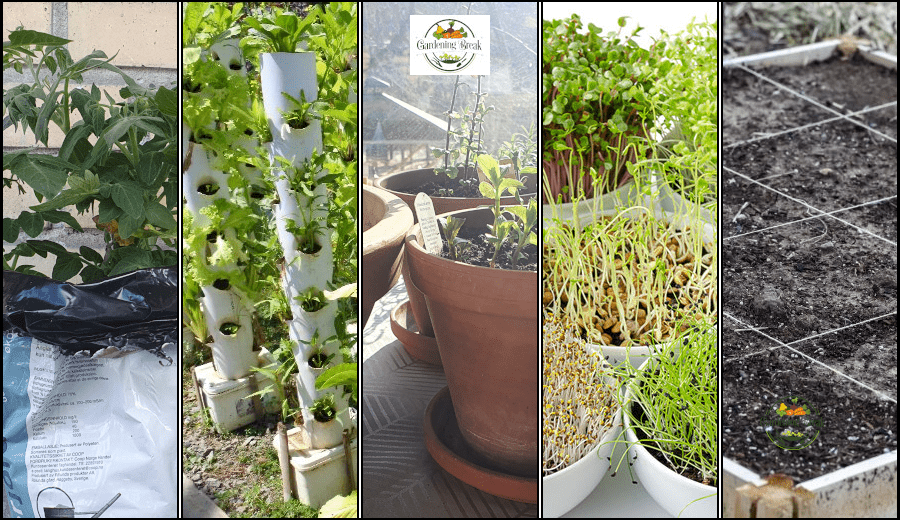
Having a small space for gardening puts some limitations on how you can grow your plants and, of course, how many you can grow. Luckily, there are some excellent gardening methods that work really well in small spaces.
I used to have a very small space to do my gardening, so I tried a bunch of different methods to see which worked best and how I could get the most out of the space I had. I ended up with five gardening methods that I want to teach you about since they worked really well for me in the small space I had.
I have written this article to help you figure out which of the five gardening methods is best suited for you, the space you have, and the type of gardening you prefer. You can, of course, also try all five methods to see which you like more.
You don’t even necessarily need a garden for most of these methods. Some of them work really well on a balcony, a terrace, or even indoors as long as there is enough sunlight. If all you have is a small space like that, I encourage you to read the article on this link, where I explain 16 tricks I have used to maximize the yield from a tiny space I used to have.
If you don’t want to read through the whole article, I summarize the strengths and weaknesses of each of the five methods at the end of the article.
No matter which of the five methods you end up trying, choosing the right plants is very important. That’s why I wrote another article, where I cover 43 herbs, vegetables, berries, and even fruit trees that you can grow in small spaces. The article is based on my own experience and on input I got from 6 gardening experts before I wrote it. You can find it on this link.
Sack Gardening: Using Grow Bags or Sacks to Grow Plants
Sack gardening is not only a very simple and easy way to grow plants but also a good way to do it in a space-efficient way, which is why it is a good potential choice for a small space. There are multiple advantages but also some disadvantages to sack gardening, which I will explain now, so you can see if it is a good fit for you.
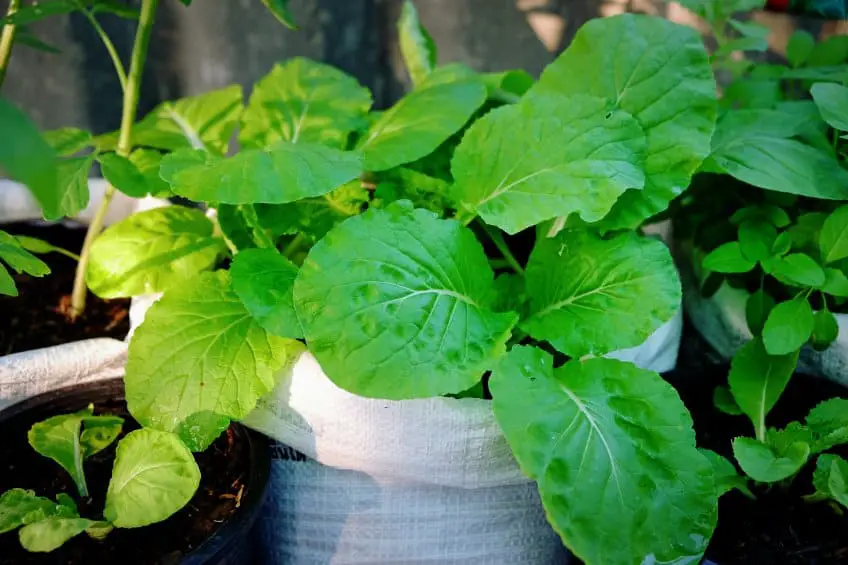
As the name (and the photo) indicates, sack gardening is about growing your plants in grow bags or sacks.
One of the major strengths of sack gardening is that you can move the plants around very easily. This makes it an excellent choice for a small space since you can easily move the plants around as they grow to make sure all of them get the sunlight and space they need.
I have done a bit of sack gardening myself and while I surely did enjoy the part about being able to move the plants around easily, I stopped doing it simply because I didn’t think it looked very good, but that was my own fault.
You can buy some pretty nice-looking grow bags and if you do that, you can definitely make a sack garden look very nice. I just didn’t have nice-looking grow bags at the time, so I used the plastic bags the soil came in instead, which worked fine but did not look that nice.
If you are considering if sack gardening is a good gardening method for you, I recommend that you head over to this article, where I cover the advantages and disadvantages in more detail than here.
When is sack gardening a good choice?
Sack gardening is a very good choice if you have a small space for growing since you can keep plants closer together than otherwise. This is possible since they are growing in individual bags, which means that they won’t spread and take over each other’s space.
Another reason why sack gardening is a good choice for a small space is that you can easily move the plants around as they grow to prevent them from casting too much shade on each other.
Vertical Gardening: Grow Taller and Save Horizontal Spce
Vertical gardening saves a lot of horizontal growing pace by utilizing the vertical space. This makes it a very efficient way to grow a lot of plants in a small space.
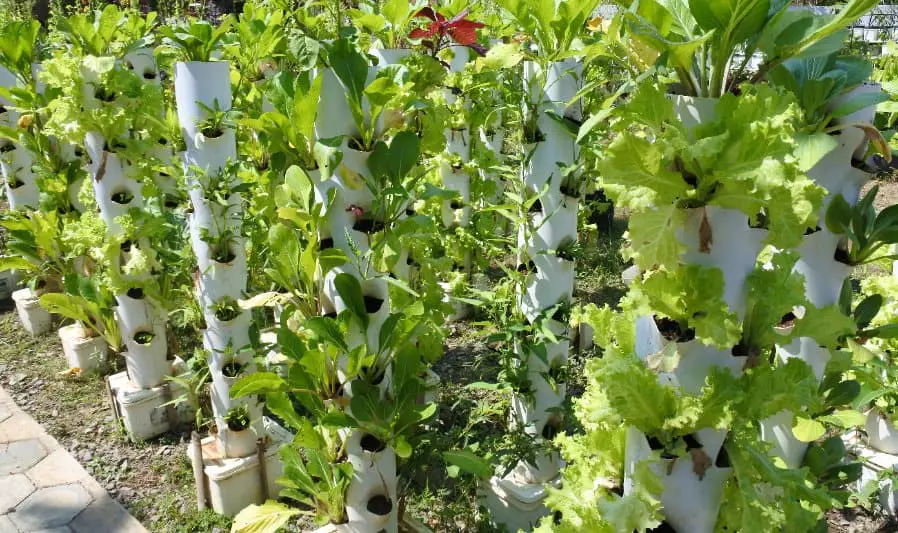
There are more ways to do vertical gardening and the best way depends on what you want to grow.
If you want to grow spinach, lettuce, strawberries, herbs, and other smaller plants, I highly recommend trying a tall pipe-like pot with many openings along the sides like the ones in the photo above. With one of those pots, you can grow a lot of plants in very little horizontal space.
All you have to do is fill the pot with soil and sow a few of your preferred seeds in each of the openings like you would in any other type of pot. After some time, you will start seeing plants growing all over the sides and top of the pot.
For indeterminate tomatoes, cucumbers, squash, pole beans, and other larger plants that climb or grow like a vine, this type of pot is not a good choice. Instead, I recommend using a trellis, which is essentially just a small construction that your plants can climb on.
You can buy trellises specifically designed for helping plants climb, but you can also use fences, long sticks, or basically anything else you can use to build a construction for the plants to climb on.
I have used a lot of long bamboo sticks in the past, which has worked great for making tomatoes, cucumbers, and other plants grow tall while taking up almost no horizontal space. In my experience, it can be a bit hard to set up bamboo sticks so they stay stable though, so an actual trellis might work better.
No matter how you decide to do it, vertical gardening is one of the most efficient ways to save horizontal space in a garden.
When is vertical gardening a good choice?
Vertical gardening is almost always a good choice, no matter how large your garden or growing space is.
It is especially powerful in small spaces, however, since it can help you grow a lot more plants than otherwise by utilizing vertical space. If you do it right, you can multiply your harvest several times with vertical gardening.
Container Gardening: Grow Plants in Individual Containers
Container gardening is one of my favorite gardening methods since it is an easy way to scale your garden to whatever space you have available while also keeping plants separated and easy to move around. Plus I think it can look really good.
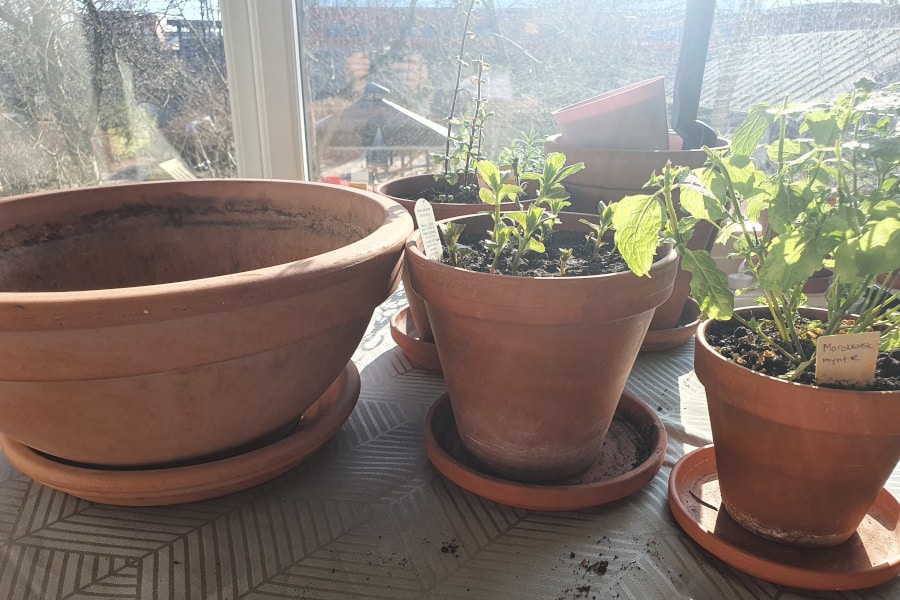
The fact that you can scale a container garden to perfectly fit whatever space you have is what makes it such a good gardening method for small spaces.
You can also combine container gardening with some of the other methods I have written about in this article such as vertical gardening. Simply push a long bamboo stick or similar deep into the soil for your tomatoes, cucumbers, or other climbers to climb on.
Another advantage of container gardening is that you can easily add and remove plants throughout the season so that you can utilize the space you have to the fullest at all times.
Of all the gardening methods I write about in this article, container gardening is by far the one I have used (and still use) the most because of all the advantages I have already mentioned.
You can even buy square or rectangular containers so that they can stay right up against each other without wasting any space. This will help you get even more out of the space you have.
The only disadvantage of container gardening I can think of is that pots are not necessarily cheap. Sure you can get some cheap plastic pots and that might work just fine. The issue, however, is that plastic is not breathable at all, so it can create humid growing conditions, which increases the risk of mold and other problems.
So as you can see, the material your containers are made of is very important. I highly recommend terra cotta or other unglazed clay materials since they are highly breathable, which creates a healthy environment for the roots in the soil.
I almost always use terra cotta pots like these (link to Amazon). I also have a couple of plastic containers but I have a lot fewer problems with my terra cotta pots.
That said, you can actually also recycle materials such as old tin cans as containers for growing plants. I did this one summer just to see if it would work since it would be a good way to recycle my tin cans and squeeze in a few more plants wherever I had room. It turned out to work surprisingly well. You can read more about that and how to do it yourself on this link.
When is container gardening a good choice?
Container gardening honestly works well almost anywhere regardless of how much space you have. That said, it is an especially good gardening method for small spaces since it is so easily scalable. You can easily move plants around or remove or add plants to make sure you utilize all the space you have at all times.
Grow Microgreens: The Method That Requires the Least Space
Microgreens are vegetables or herbs that are harvested just after the first set of true leaves appear. They are usually grown very densely, which makes them great for small growing spaces.

Microgreens can be grown practically anywhere. They grow fast, don’t need much space, and don’t require perfect growing conditions, making them a great choice to grow in any excess space you have no matter the size.
I have grown a lot of microgreens and I still almost always have one or a few small trays with microgreens growing, because I like them so much. You can grow microgreens outside, but you can also easily grow them inside. In fact, it can be a lot easier to grow them inside in my experience.
The reason why growing microgreens is such a great method for small spaces is that they are really space-efficient and grow so fast that you can grow many rounds of many different types of microgreens. Depending on the type of microgreens, you can already harvest within 1-4 weeks of sowing.
Microgreens are not only space-efficient to grow. They are also really easy. They don’t even always need soil to grow. I have literally grown several different types of microgreens with toilet paper (unused!) as a growing medium. I’m not saying that was the best way to do it, but it sure was easy.
One of the challenges with microgreens is knowing when to harvest them. If you harvest too early, you don’t get as much out of them as you should and if you harvest them too late, they can get stringy and bitter. That is why I wrote this article, where I explain how you can know when you should harvest your microgreens.
When is growing microgreens a good choice?
Growing microgreens is a good choice if you don’t have the space for the other methods I have covered in this article. It is also a great choice if you want to see fast results since they are harvested at a very early stage.
Some microgreens taste great to eat by themselves or as a garnish. I especially like peashoots and radishes and I very often have some growing.
Square Foot Gardening: An Easy Way to Divide a Space
Square foot gardening is a really good way to divide whatever growing space you have into smaller areas. It can help you grow a lot of different things in a small area while still keeping things simple and having a good overview.
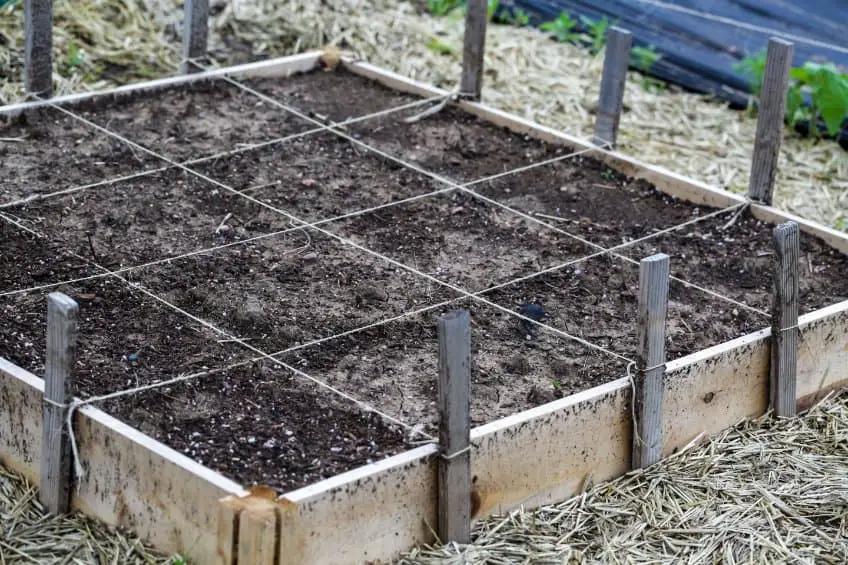
When you do square foot gardening, you use some thread or wire and some nails, sticks, or otherwise to divide your space into smaller spaces, each one square foot in size like in the photo above.
You then use each of the squares you created as a smaller space for a specific variety. How many of each plant you sow per square depends on the variety. For example, you can have multiple basil plants, carrots, or green onions in a single square, but you don’t want to have more than one tomato plant per square.
The primary advantage of square foot gardening in a small space is that it can help you know exactly how many of each plant you can fit into your garden, thereby optimizing how much you get out of it.
As I was doing research for this part of the article, I found this article from gardeninminutes.com that explains how you can tell how many of each plant goes in a square.
While square foot gardening is a great way to optimize how many plants you can have, you have to be careful not to overcrowd your plants since that has a lot of negative consequences (which you can read more about here).
If you are not sure how to tell if your plants are overcrowded, I recommend this article where I explain how to tell and how to save them if they are.
As I am writing this, I don’t have quite as much experience with square foot gardening as I do with the other methods I have written about in this article, so if you want to learn more about it, I highly recommend that you watch this video from The Gardening Channel With James Prigioni.
When is square foot gardening a good choice?
Square foot gardening is a great choice for optimizing how many plants you grow while still giving them enough space. It is an excellent choice for both beginners and more advanced gardeners since it can help you keep an overview of your garden while allowing you to grow many different varieties.
In Conclusion: Which Method Is Right for You?
My goal with this article was to help you figure out which gardening method suits you best for whatever space you have. To do that, I have made a table where I summarize the strengths and weaknesses of each of the five methods I covered in this article.
| Small-space gardening method | Strengths | Weaknesses |
| Sack gardening | -It is easy to move plants around -Can easily be scaled to fit your space | -Good grow bags can be expensive |
| Vertical gardening | -Can multiply your harvest without using more horizontal space -Very versatile for different plants | -Tall plants can cast shade on other plants |
| Container gardening | -It is easy to move plants around. -Can easily be scaled to fit your space -Terra cotta pots are highly breathable which creates a good environment for the roots | -Plastic containers are not breathable which can cause problems -Terra cotta pots can be expensive |
| Microgreens | -Can be grown almost anywhere -Can be grown at almost any time -Can be scaled to whatever space you have no matter how small | -Not as much variety diversity as in other types of gardening |
| Square foot gardening | -Great for keeping an overview of your plants and garden space -Great for growing as many plants as possible -Great for growing different varieties | -Does not work with containers -Requires a divisible growing space like a raised bed or similar |
Remember that nothing is stopping you from trying more than one of these gardening methods. They all have their individual strengths in a small space.
If you are not sure if gardening in a small space is worth it, I highly recommend reading this article. In it, I cover the advantages and disadvantages of gardening in a small space that I learned from using a small balcony for gardening for a few years.

